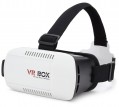Max. phone screen size
The largest diagonal of a smartphone compatible with the corresponding glasses (see "Intended use"). Note that this parameter can be specified both for universal models that do not have specialization for specific mobile phones, and for gadgets for specific devices (for more details, see "Compatible phone models"). The maximum diagonal is connected both with the features of the optics and with the physical dimensions of the "seat" for a mobile phone — a gadget that is too large simply does not fit there.
Note that even the smallest glasses for smartphones work quite correctly with devices with a diagonal of
5 – 5.5 ". So it makes sense to pay attention to this parameter if your device has a larger screen size. Nowadays, you can find glasses for gadgets
5.6 – 6 " and even
6" or more.
Field of view
The viewing angle provided by virtual reality glasses is the angular size of the space that falls into the user's field of view. Usually, the characteristics indicate the size of this space horizontally; however, if you need the most accurate information, this point needs to be specified separately.
The wider the viewing angle — the more the game space the user can see without turning his head, the more powerful the immersion effect and the less likely that the image will be subject to the "tunnel vision" effect. On the other hand, making the field of view too wide also does not make sense, given the characteristics of the human eye. In general, a
large viewing angle is considered to be an angle of 100° or more. On the other hand, there are models where this indicator is 30° or even less — these are, usually, specific devices (for example, drone piloting glasses and augmented reality glasses), where such characteristics are quite justified given the overall functionality.
Headphones
The presence
of your own headphones in the design or delivery of virtual reality glasses.
A full-fledged "immersion" in the virtual world requires not only a picture on the screen, but also an appropriate sound accompaniment, for which headphones are the best option. However, glasses take up quite a lot of space on the head, and not all “ears” can be comfortably combined with them (this is especially noticeable on large over-ear headphones). In addition, when connecting headphones with a wire, there may be problems related to the length and/or location of the audio cable. Thus, some models provide this function. These models can have any purpose (see above); most of these are for PC/console glasses, but headphones are also popular in standalone devices. Also note that some glasses use speakers located in the ear area; such speakers are also considered headphones in this case.
An alternative to the bundled "ears" is a headphone output; however, there are models with both functions at once — either folding / removable cups or the simplest speakers mentioned above play the role of headphones in them.

